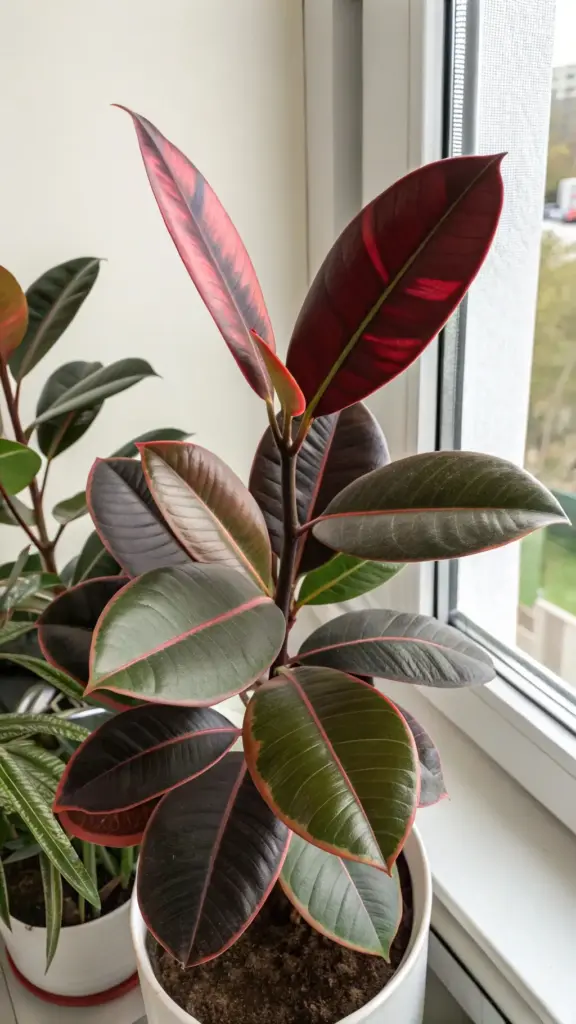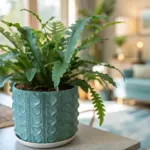2. Ficus elastica ‘Ruby’ – The Burgundy Beauty

When I first brought home my Ficus elastica ‘Ruby’, I thought the nursery had mislabeled it. The leaves were so deep burgundy they almost looked black in certain lighting.
This plant completely changed my perspective on what rubber plants could look like. Gone were the days of plain green foliage – this beauty was serving up drama in every single leaf.
Those Show-Stopping Red and Pink Hues
The deep red foliage on a ‘Ruby’ isn’t just red – it’s this incredible spectrum of burgundy, crimson, and soft pink undertones. It’s like having a living piece of velvet in your living room.
What really blew my mind was discovering that the new growth emerges almost black. I’m talking deep, dark burgundy that’s so intense it looks nearly purple.
As the leaves mature, they develop these gorgeous pink highlights along the edges and veins. The color variation within a single plant is absolutely stunning.
The leaf texture has this almost glossy, leather-like quality that makes the colors pop even more. Under bright light, you can see subtle pink undertones that aren’t visible in dim conditions.
Growth Patterns I Wish Someone Had Told Me
Here’s something that caught me off guard – ‘Ruby’ plants grow slower than regular rubber plants. Don’t expect rapid growth spurts like you’d see with a standard elastica.
My mature plant reaches about 6-8 feet indoors after several years of growth. The branching pattern tends to be more compact and bushy compared to the tree-like structure of regular rubber plants.
New leaves unfurl in the most dramatic way – they start as these tight, dark burgundy spirals that slowly open to reveal their full color intensity. The whole process takes about 2-3 weeks.
Stem coloration is another unique feature – they’re often reddish-brown instead of the typical green you’d see on other varieties.
Seasonal Changes That Keep Things Interesting
This is where the ‘Ruby’ variety gets really fascinating. The colors actually shift throughout the year based on light exposure and temperature changes.
During winter months, when light levels drop, the burgundy tones become even deeper and more intense. It’s like the plant is concentrating all its color into fewer hours of daylight.
Spring and summer bring out more of those pink undertones I mentioned earlier. The contrast between old and new growth becomes really pronounced during active growing seasons.
I’ve noticed that temperature fluctuations also affect coloration. Cooler nights seem to intensify the red pigments – something about anthocyanin production that I learned from a plant biology course.
Propagation Secrets That Actually Work
Propagating ‘Ruby’ plants can be tricky because of their slower growth rate. I’ve had the most success with stem cuttings taken during late spring or early summer.
The key is getting cuttings with at least 2-3 nodes and that gorgeous burgundy coloration. Plain green cuttings won’t give you the same color intensity in the new plant.
Water propagation works, but it takes forever – we’re talking 6-8 weeks before you see decent root development. I prefer using a rooting hormone and planting directly in well-draining potting mix.
Here’s my secret trick: I keep propagation containers in bright, indirect light with consistent warmth. A heating mat underneath really speeds up the rooting process.
Room Placement for Maximum Drama
The ‘Ruby’ variety is all about creating visual impact, so placement is everything. This isn’t a plant that blends into the background – it demands attention.
I’ve found that living rooms with neutral color schemes really make the burgundy foliage pop. Think white walls, beige furniture, maybe some gold accents.
East-facing windows are perfect because the morning light really brings out those pink undertones. Avoid south-facing windows unless you have sheer curtains – too much direct sun can fade the beautiful colors.
My favorite placement is actually in a home office or reading nook. The deep colors create this cozy, sophisticated atmosphere that’s perfect for focused work.
Contrast is key – I pair mine with light-colored planters and avoid busy patterns that compete with the dramatic foliage.
Want to see a variety that’s even rarer and more exclusive? Hit that next button to discover the Ficus elastica ‘Sophia’ – the holy grail of rubber plant collecting that serious enthusiasts guard like a family secret!









GIPHY App Key not set. Please check settings